Types of magnetic separators: classification, application
- #How to choose a magnetic separator
- #Recommendations
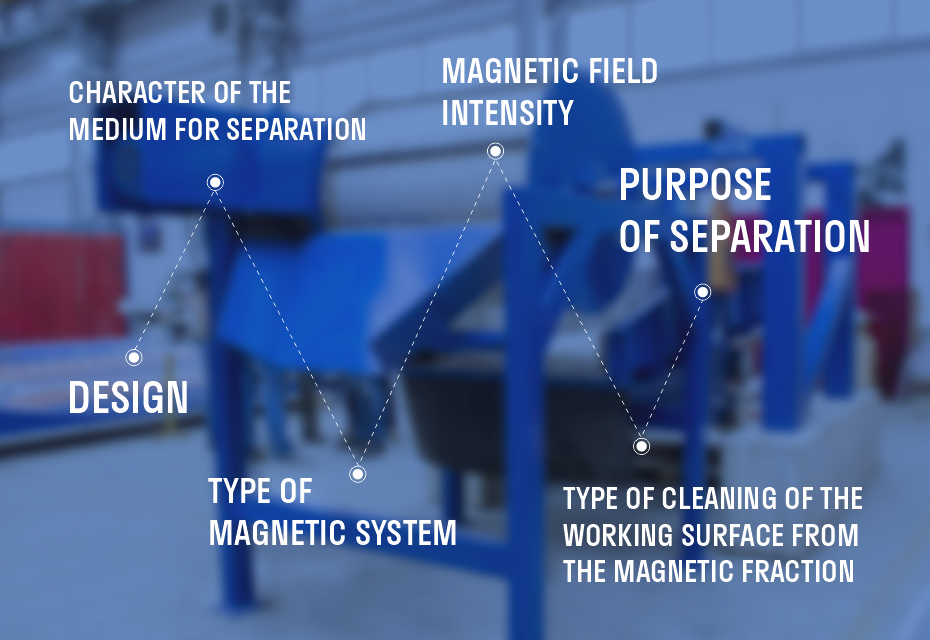
Types of magnetic separators
ERGA produces more than 40 models of magnetic separators, which can be classified using the following parameters:
>> Depending on the character of the medium for separation
>> Depending on the type of magnetic system
>> Depending on magnetic field intensity
>> Depending on the type of cleaning of the working surface from the magnetic fraction
>> Depending on the purpose of separation
Depending on the design:
This separator represents a magnetic system in the form of a plate, protected by a casing. Plate separators are installed in pipelines and gravity pipes for removal of occasional coarse and medium metal inclusions.
#ERGA PlateMag A #ERGA PlateMag
Separators of this type are installed over the conveyor belt for removal of coarse magnetic impurities from the conveyed material flow. Iron separators consist of a long-range magnetic system in the form of a block, a protective casing and automatic or mechanical cleaning system.
#ERGA SuspendMag P #ERGA SuspendMag M #ERGA SuspendMag A
They consist of magnetic sector and drum shell rotating around it. They can solve a wide range of tasks: from recovery of dense media in the form of magnetite and ferrosilicon (less than 74 microns) to coarse slag and ore sorting (350-400 mm).
#ERGA DrumMag M#ERGA DrumMag #ERGA WetMag #ERGA WetMag R
The separators include rolls with diameter up to 320 mm with installed high-intensity magnetic system. They are used for recovery of weakly magnetic minerals and impurities.
Depending on the character of the medium for separation:
1. Dry magnetic separators (air medium)
They are used for separation of bulk materials according to their magnetic properties with moisture content up to 5%.
2. Wet magnetic separators (water medium)
Separation of liquid flowing materials, pulp and slurry with solids content up to 45% by magnetic properties.
Depending on the type of magnetic system:
1. Separators with open magnetic system and magnetic stirring
Magnetic flux lines in separators with this type of magnetic system are closed through air (for dry separators) or liquid-water (for wet separators), polarity of the poles changes in the direction of the product flow, thus mixing the magnetic material and recovery from nonmagnetic particles.
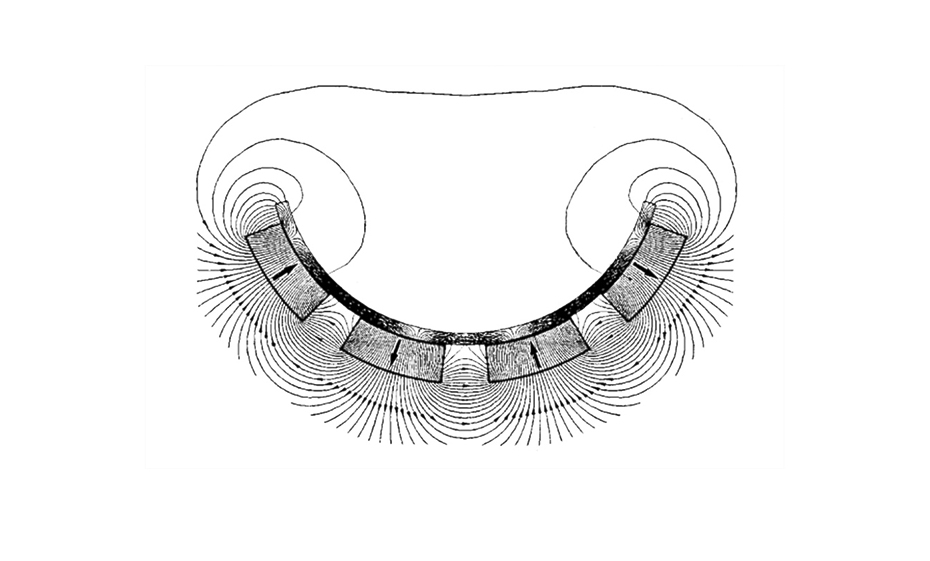
Fig. 1 Open magnetic system
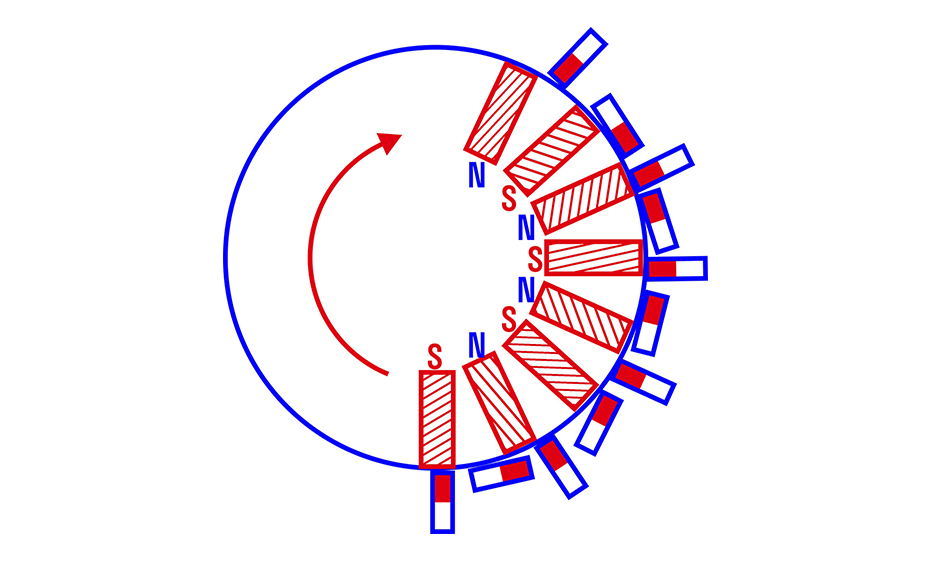
Fig. 2 Magnetic stirring system
They are used to obtain magnetic fraction with minimum content of nonmagnetic material, that is, when there are high requirements to magnetic fraction quality (obtaining magnetite concentrate, commercial scrap of ferrous metals, etc.) or losses of valuable non-magnetic product (upgrading of gold- or diamond-bearing ores, processing of nonferrous scrap). The term "open magnetic system" does not mean that the permanent magnets are open and in direct contact with the separated product. Magnetic systems of this type are reliably protected and installed inside a metal shell.
2. Separators with open magnetic system without magnetic stirring
Polarity of the poles does not change as the product moves, thereby maximizing the retention of the magnetic material on the working surface.
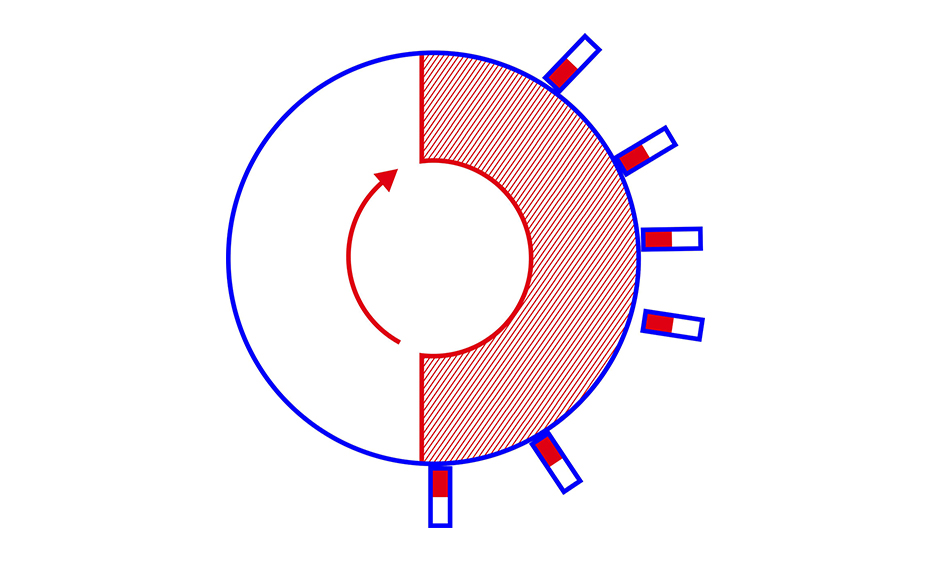
Fig. 3 System without magnetic stirring
They are used to maximize recovery of magnetic fraction when the magnetic fraction is a harmful impurity (removal of tramp metal from food products and ingredients) or has weak magnetic properties (stainless and manganese steel, oxidized iron, manganese, chrome ore, ferrous slag).
3. Separators with closed magnetic system
In closed magnetic systems, a magnetic field is generated in the space between opposed poles.
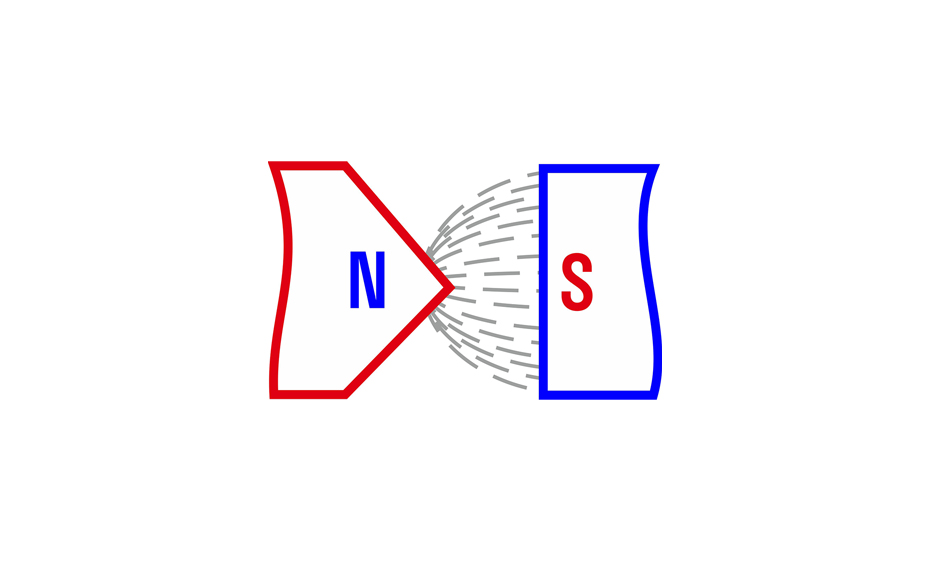
Fig. 4 Closed magnetic system
The systems are used to obtain high magnetic field intensity in the working area (over 1 T) and to extract weakly magnetic materials and minerals (ilmenite, columbite, chromite, wolframite).
4. Separators with a traveling magnetic field
A system with a rapidly rotating magnetic field is used in eddy-current separators for directing EMF to conductive product and separating material by electrical conductivity (separation of nonferrous metal slag, processing of solid waste and slags, incineration bottom ash, etc.).
Depending on magnetic field intensity:
1. Separators with low magnetic field intensity (LIMS)
Induction on the separator working surface from 50 to 300 mT. It is used in equipment for recovery of coarse inclusions with ferromagnetic properties in the process of iron separation, as well as for the production of iron ore concentrates during beneficiation of magnetite ores, metal concentrates in processing of ferrous metal slags, scrap metal.
#ERGA WetMag #ERGA DrumMag M #ERGA SuspendMag A #ERGA PlateMag
2. Separators with medium magnetic field intensity (MIMS)
Induction on the separator working surface from 300 to 900 mT. It is used in equipment for extraction of fine magnetic impurities (for example, metal rubbing), with strict cleaning requirements (food industry), for removal of medium magnetic inclusions (scale, cast iron) or minerals (martite, ferberite, wolframite, manganese tungstate).
3. Separators with high intensity of magnetic field (WHIMS and DHIMS)
Induction on the separator working surface from 900 to 1500 mT. Recovery of weakly magnetic impurities (stainless steel) and minerals during beneficiation of quartz sand, manganese, chromium, titanium-zirconium and other ores.
Depending on the type of cleaning of the working surface from the magnetic fraction:
1. Separators with manual cleaning
Magnetic impurities are manually removed from the working surface.
2. Separators with mechanical cleaning
Magnetic separators are cleaned by the operator using a cleaning mechanism.
#ERGA SuspendMag P #ERGA SuspendMag M
3. Separators with automatic cleaning
Magnetic impurities are removed without participation of the operator, automatically, continuously or in set periods.
#ERGA PlateMag A #ERGA DrumMag #ERGA WetMag
Depending on the purpose of separation:
1. Separators for iron removal to protect grinding, crushing and other equipment
A wide class of magnetic separators used for removal of coarse industrial iron (ball fragments, metal equipment parts) from the material flow.
#ERGA SuspendMag P #ERGA SuspendMag M #ERGA SuspendMag A #ERGA PullMag #ERGA TrunMag
2. Separators for obtaining valuable magnetic fraction
The result of the separation on this type of equipment is magnetic fraction with high content of iron (processing of slag, scrap), magnetite (concentration of iron ores), ferrosilicon (dense media recovery) or other valuable magnetic material. The resulting fraction has industrial purpose and increased cost compared to the original product.
#ERGA DrumMag #ERGA WetMag #ERGA WetMag R
3. Separators for removing harmful magnetic impurities
In food, refractory, glass industries, man-made or natural iron is a harmful impurity, and its content is standardized by State Standards. For example, for wheat flour, the content of a metal-magnetic impurity over 0.3 mm and weighing more than 0.4 mg should not exceed 3 mg per 1 kg of product.